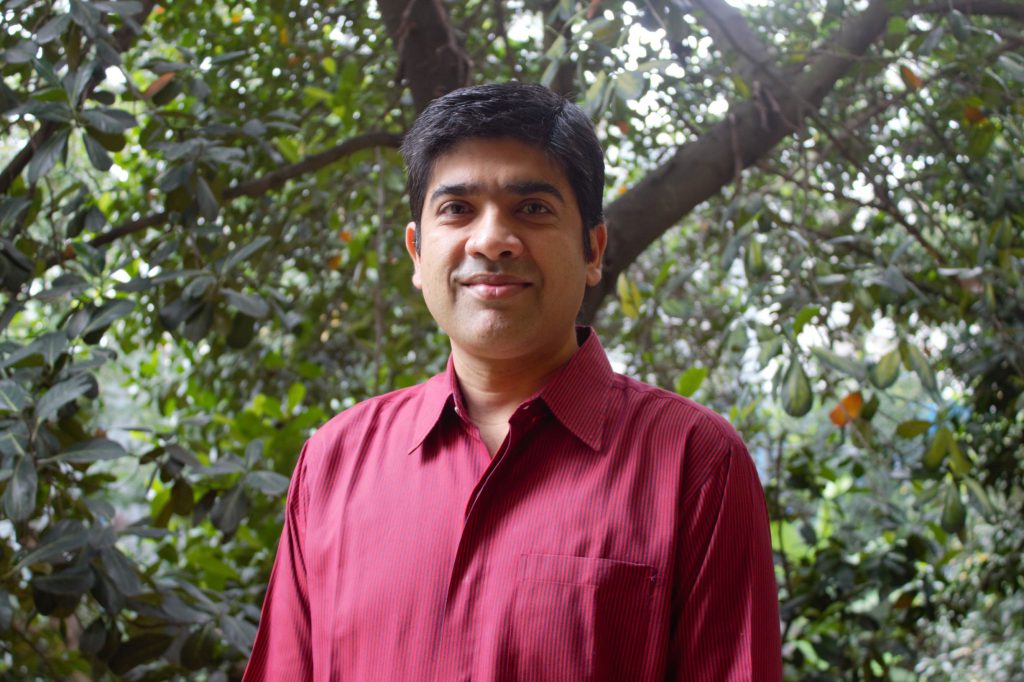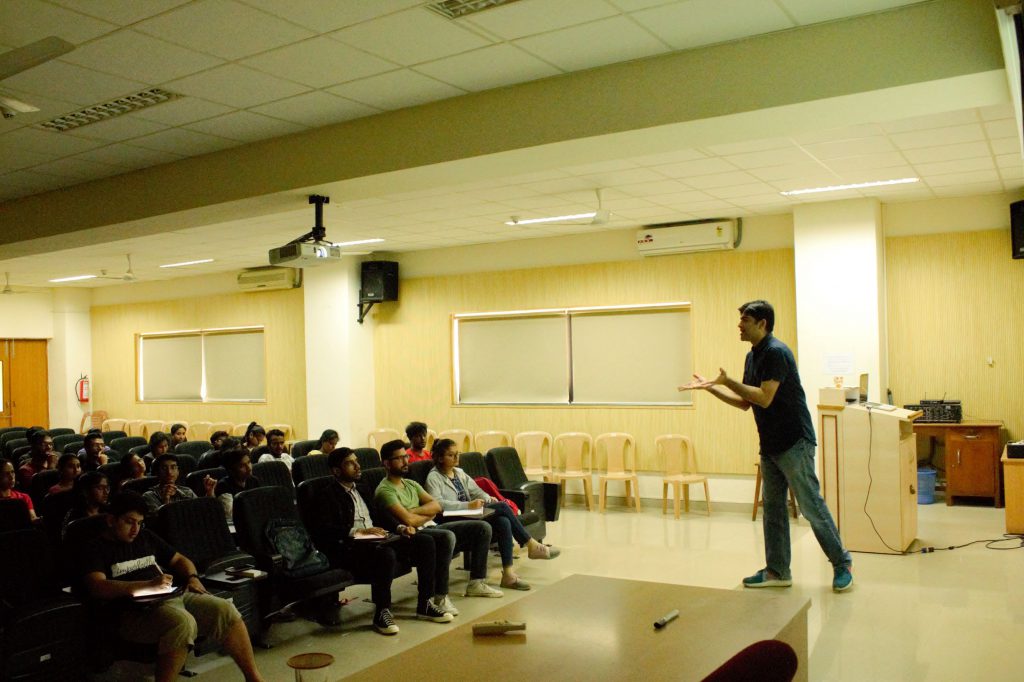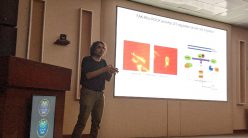A biochemistry researcher shares his experiences as a new teacher

This article is an attempt to put together my experiences over the last six years of teaching biology. Since joining as a research faculty at IISc, I have learnt that teaching is a tough but also an extremely rewarding (both scientifically and emotionally) activity when done the right way. As research institutions across India are increasingly focused on imparting quality education, I consider it imperative that every researcher aims to be a good teacher. I have been striving to be one, but at this point, I am far from it. In this article, I share my opinions based on my personal experiences. These experiences have helped me improve my teaching and connect better with the students – in the class, as well as in the laboratory.
Laboratory teaching versus classroom teaching
I believe that every researcher should aspire to be a good teacher. This might sound simple, but explaining new information to students can be challenging. I realised this after taking up my assignment as an independent researcher. In principle, teaching in a laboratory to graduate students at the bench should not be different from teaching a classroom full of students. In practice, this is not the case. The former involves talking to your students about the subject one has expertise on. This is where we excel since we are well versed in our respective research domains. We have thought about the subject in different ways, and hence explaining it to a newbie is a relatively easy job.
In principle, teaching in a laboratory to graduate students at the bench should not be different from teaching a classroom full of students. In practice, this is not the case.
Classroom teaching, on the other hand, is often not about our own research. It also involves dealing with a large number of active minds working on the same problem at a given point of time. I like to think that clarity of expression on the part of the teacher promotes clarity of concept in student minds, empowering them to think about the concepts and pose challenging questions to the teacher. As researchers, we are often egoistic about what we know. Yet, a good classroom question could sometimes leave us stumped. When I began my classroom teaching, I was a bit reluctant to say, “I do not know the answer at this point. However, I will read more about it and get back to you.” It took me a while to gather the courage to say this in class. Every time I do it now, it forces me to go back and read about the topic afterwards, and address it in my next class. This has reduced my anxiety during teaching a great deal.
Having had no formal classroom teaching experience, I was asked to teach a subject that had failed to fascinate me as a student. I was asked to teach synthesis and breakdown of biomolecules (or metabolism) to a class of about 30 students, who were a mix of PhD and integrated PhD students. As I began to teach a part of this 3-credit course, it dawned on me that many students found learning about biochemical pathways boring. My classes were listless, and I was finding teaching difficult.
After giving it some thought, I realised that I could not reinvent metabolic pathways to make them interesting, but I could certainly change the context of the class. I decided to focus on the regulation of pathways and their connections to other cellular processes. For example, a key gluconeogenic enzyme, fructose-1,6-bisphophatase (FBP-1) had recently been reported to perform multiple roles within the cell nucleus, one of which served to antagonise renal cell carcinoma progression. This report turned out to be an excellent tool for me to discuss in the class because it invariably involved first learning about the canonical role of FBP-1 in gluconeogenesis. I have discussed this article every year since 2015 in my course. I have observed a clear difference in the enthusiasm of students in terms of their participation in classroom discussions before and after the introduction of this article.
Students still learn biochemical pathways in my class but the eventual aim is also to understand recent regulatory aspects of a pathway, or a novel role of an ‘old’ enzyme. I have added newer articles to keep the course content updated. In 2017, I incorporated another article as a part of teaching glycolysis. This article reported the association of glycolytic enzymes into glycolytic bodies (G bodies), and the importance of this association during hypoxia response and tumorigenesis. It focuses on the exciting discovery of G-bodies and their significance. While trying to understand the article, students invariably become familiar with the process of glycolysis. Perhaps a similar approach can be applied to other topics to make both the teaching and the learning processes more interesting. It can be argued that the above approach could dilute the significance of the specific metabolic pathway that I am supposed to teach. However, I perceive that students appreciate the concept of metabolism better when they realise that the pathways and cycles are also connected to other cellular processes.
Scientific videos can be a wonderful teaching aid
Despite the debate on their usefulness, the use of PowerPoint presentations in classroom teaching is commonplace. I find PowerPoint presentations an effective way of communicating my thought process to the students. However, PowerPoint is not the be-all-end-all for teaching. I learnt this as I was preparing for a new teaching assignment.
A colleague of mine came up with the idea of offering a new course on ‘The Molecular Basis of Ageing’ and (luckily for me) wanted me to be a part of it. I decided to teach about another related component – ‘How Animals Regenerate’ – an addition that would make the course more interesting. Thankfully, my colleague agreed and we started offering a course on ‘The Molecular Basis of Ageing and Regeneration’. My research interests in the lab did not involve the study of ‘regeneration’ in any manner, but I was fascinated by it. I started preparing for the first batch of students and soon realised that there was little in standard biology textbooks about regeneration. A majority of the students crediting the course turned out to be undergraduate students. This was unexpected as it was an advanced course and we had anticipated that mostly graduate students would opt for it. And so, I prepared to explain to undergraduate students an advanced course that was minimally covered in textbooks.
I had decided to focus on hydra, planaria, salamander, and zebrafish as these model systems have contributed a lot to our current understanding of regeneration. Searching the literature for a way to introduce regeneration and these model organisms in my first class, I came across some videos about these animals. One such video was a short interview of Alejandro Sanchez-Alvarado, who has almost single-handedly established planaria as a ‘poster animal’ for studying regeneration. With short clips, he explains how this animal has been instrumental in shaping our understanding of regeneration and stem cell biology. There are similar videos about salamander and hydra. I decided to include these videos in my first few classes. The impact of the initial classes was evident. It generated curiosity among the students for the remaining classes. Over the years, the first few classes of this course have served as a curtain-raiser that piques students’ interest in the phenomenon of regeneration. The heightened curiosity makes them more receptive to understanding the complicated mechanistic details that follow in the subsequent classes. The point I am making here is simple. There are numerous teaching aids like videos and podcasts that are freely available to most of us. The challenge often is to find the aid that best fits our subject and style of teaching.
An alternate version of this approach would be to prepare a video lecture (or online lecture) for a given topic and let it do all the teaching every year in the classroom. This is practiced by some colleges and universities. The idea that such a form of teaching will one day replace live face-to-face teaching in the classroom is realistic. However, studies indicate that students’ grades can suffer in online courses, as compared to live face-to-face courses. At this point, I personally support classroom teaching, using videos merely as an aid. I opine, based on my perception, that the quality of teacher-student interaction (an integral part of the learning experience) attained in traditional face-to-face teaching is tough to replicate online. Having said that, given the current pandemic, I am preparing myself for my first ever online teaching experience starting this October.

Students as teachers in the classroom
It has been suggested that the learning process comprises three steps: 1) actively seeking information, 2) arranging it logically and coherently, and 3) explaining it to others. I realised early on that I did not put enough emphasis on letting students go through this entire process, except during exams. It was not surprising that I benefitted the most from the teaching routine and not so much my students!
I currently teach three different courses in an academic year. While teaching, I try to relate the textbook content with recent advances in the literature. In the past six years, a pattern has emerged in my approach to teaching. After every few classes of conventional classroom teaching about the basics, I discuss relevant and recent advances in research. Initially, I would discuss the research article by going through some important figures to highlight the importance and relevance of the study. Over a period of time, this exercise has evolved to be completely driven by the students during which I become a facilitator for the exchange of ideas. To make it inclusive, the class is divided into small groups of three to four students, and each group is assigned a certain part of the paper that they have to explain to the rest of the class in 10-12 minutes. The presenter for a given group is selected by drawing names just before the presentation. This ensures that all students in the group put in an effort to prepare. Such a group learning activity pushes the students to go through the three key steps of the learning process described earlier. Most of the students have embraced and appreciated this activity as they relish being in charge as a ‘teacher’ while trying to convey the concept. I have learned this based on their feedback, both immediately after the presentations and at the end of the semester.
An obvious caveat of this approach is that a group might focus only on the part of the article they need to present, defeating the purpose of such a group learning activity. I have learned to overcome this issue to some extent by assessing each group through the questions and discussions they bring up while other groups are presenting. This encourages all the groups to read the entire article carefully. Not surprisingly, the groups in the audience are highly motivated to question and discuss with the presenting group since the ‘teachers’ are their own classmates, and hence the inhibition associated with questioning your teacher is reduced.
Making students aware of the history of science
Although the importance of teaching students the history of science has been documented, it took me some time to realise this in my metabolism classes. While trying to answer a student’s question about how each reaction in the pathway of glycolysis was identified, I realised that I should incorporate the history of how metabolic pathways were discovered. It prompted me to include details of Eduard Buchner’s seminal experiments using yeast ‘juice’ and sucrose, that led to the accidental observation that metabolism is as much chemistry as it is biology. Personal experience has taught me that instead of just explaining the concept to the students, if I take them through the experiments that led to it, they are more receptive to the idea. I begin by explaining classic research articles that led to the genesis of a given concept. For example, the history of the “one gene-one enzyme” hypothesis that involved Beadle deciding to use the fungus, Neurospora led to the emergence of biochemical genetics. While discussing this, I make sure to impress upon students that such simple and inexpensive experiments using specific model systems can be designed even today, to address complex biological problems. There is another benefit of making students aware of the history of science. It makes them realise the abundance of resources available to them to perform experiments, as compared to what was available to the scientists who made these path-breaking discoveries. And that impactful research need not always require cutting edge technology.
Initially, the idea of discussing the history of science was to simply explain the experiments that led to the concept. Over the past couple of years, it has been modified to also include a component on how to read a research article.
Initially, the idea of discussing the history of science was to simply explain the experiments that led to the concept. Over the past couple of years, it has been modified to also include a component on how to read a research article. Since the articles are old, the techniques are simpler and hence easier to comprehend for students. In the beginning, I present one such article to the class explaining to them the importance of the question that was addressed in the article. I then go through each figure and explain the author’s point of view. I also provide an alternative point of view, or a different interpretation of the experimental data in the article. This would lead them to think about what else the authors could have done to ensure that their interpretation is the correct one, resulting in the design of new experiments. The aim is to convey to the students ‘why’ and ‘how’ the chosen article made a difference to the field. Subsequently, the class presents another such article using the same group presentation approach described earlier. The difference here is that they are instructed to focus on coming up with their own interpretation of the data while understanding the author’s viewpoint. This encourages them to come up with alternative hypotheses and new experiments to test. I extend this teaching to the course examinations as well, where a quarter of the questions test their ability to interpret the given data and come up with possible experimental strategies (for articles discussed in the class during the course).
Overall, the past six years of teaching has been a fantastic experience for me. I am convinced that teaching is a great way of learning when done the right way. I hope my perception of teaching presented in this article will be helpful to others who are trying to figure out how to go about teaching when they begin. The idea of this article is also to get feedback from the readers (both students and teachers) that will help me improve both as a teacher and as a researcher.
Purusharth I Rajyaguru is an Assistant Professor at the Department of Biochemistry, IISc. He can be contacted at: rajyaguru@iisc.ac.in
This is an edited version of an article that was first published in Resonance (Vol 25, Issue 9). The original article can be found here.

